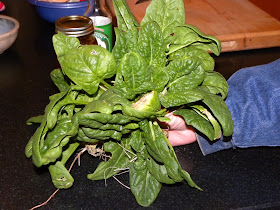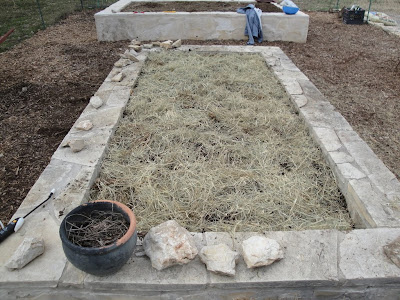About three years ago, my husband and I bought a compost barrel to compost our kitchen waste. It seemed senseless to throw away all that good organic material, not to mention the acres of decaying leaves on our property just lying there. I still toss some kitchen scraps over the fence line for the deer, but most of it goes in the compost bin. The bin we bought is a
Mantis ComposT-Twin Compost Tumbler and I really like it!
It took a while for the material in the bin to break down into useable compost but just before Thanksgiving, I dumped my first load of homemade compost into one of my beds! It was so neat to be able to do that.
Many of my friends have asked me about composting so I thought I'd share a little bit of what I know about composting and what has worked for me.
First off, what is compost? Compost is simply decomposed organic matter, either plant or animal. Composting is also a natural process that occurs continuously in nature with no help from man. Think walking in the woods with all the rich, soft, sweet smelling soil underneath your feet...that is compost in its purest form.
Composting is great for two very compelling reasons...it's great for your garden and it is environmentally responsible. The less "stuff" we put in landfills, the better for our planet. Especially kitchen/lawn/plant waste that can be used to create good stuff for our gardens.
In the garden, compost improves the soil stucture making it easier for the soil to retain and utilize the right amount of moisture and air. Compost provides virtually all the essential nutrients for healthy plant growth and time-releases them to ensure a steady, slow, consistent intake of the elements essential for growth. And healthy soil = healthy plants.
It's not difficult to start a compost pile. There are two basic kinds of compost piles: open bins and enclosed containers. Open bins are usually constructed with wood, chicken wire or recycled plastic. Enclosed bins are usually upright, box-like containers with rotating drums. There are advantages and disadvantages to each system:
Open bin composting advantages:
- easy collection of rainwater and
- convenience for adding materials.
Open bin composting disadvantages:
- attraction of rodents, flies, bees and in certain parts of the country...bears
- too much moisture if not covered
- difficulty in mixing if pile becomes too large
- unattractive appearance, particulary for city dwellers
Container composting advantages:
- more aesthetically appealing
- rotating drums are easy to mix and turn
- rotating drums are easy to unload
- rotating drums usually have screens which allow for ventilation
Container composting disadvantages:
- enclosed containers usually require you to add water
- upright containers make it difficult to turn the pile
With container composting, two chamber bins are better than one. This allows for one of the chambers to "cook" the compost while you continue to add to the other bin. Which means that you have one bin cooking at all times and one for continous adding of material.
OK...once you decide which type is best for you, what to add to the compost pile? The essential ingredients for a successful compost are: food, water and air. The water and air are a given, for the most part. The food you need to work with a bit.
Food for the millions of microorganisms that make up a compost pile are categorized in two classes of material: "Greens" and "Browns". Green materials are high in nitrogen while brown materials are high in carbon. Finding a balance between the two can be tricky. The green materials provide the "microbugs" while the brown materials provide energy.
Green materials:
- fresh, green grass clippings
- kitchen scraps - fruit, vegetables, coffee grounds, tea bags, but NO MEAT SCRAPS!
- leftover (disease free) fruits/veggies from the garden
- manure - cow, horse, chicken or rabbit
Brown materials:
- decomposing (decomposed) grass clippings - brown
- hay or straw
- dried grass
It's not likely that you'll add too much brown material to your compost pile; however, too much green is usually the problem. A pile of kitchen garbage will not become useful compost. It simply becomes a pile of green, smelly garbage. It's better to add more brown than green. The best source of brown material is dry leaves and most everyone has plenty of those. During the annual fall clean up, using a leaf blower or leaf vacuum, shred and collect as much of the dry leaves as possible. Store them in large plastic bags in your garage until needed to bring the greens in your compost bin/pile into balance. Another useful element to add to your compost pile is a couple of shovels of good garden dirt. Good, active soil is full of beneficial microorganism that will help get your compost pile off to a good start.
Some people use a compost thermometer to monitor the core of the compost pile, but that's a bit technical for me. Your eyes and nose will usually tell you what you need to add to the mix. The best ratio of browns to greens is about 4 to 1. Obviously this is a very rough estimate, but a benchmark to at least begin your compost pile.
Other than the compost container itself, the only tools you'll need are:
- a pitchfork for turning and mixing the pile
- a shovel for removing finished compost from your bin or pile and tossing it into your garden
- a wheelbarrel or garden cart for transporting the compost from the heap to the garden
For efficient composting to take place, you have to have a large enough critical mass to generate a heat core. Much of the literature I've read and experienced gardeners I've talked with agree that a minimum of 1 cubic foot of raw materials is good. Of course, more is better.
Once you have your core pile established, you may be tempted to continue to add to it but all this does is set you back to Day 1. Your compost pile will decompose more quickly if you don't continuously add to it (once it's the size you want it). This is easy to do with double chamber drums (one drum "cooks"...one collects new materials), but a bit more difficult with open containers. And in open container compost piles, smaller is better. They are easier to manage and decompose more quickly resulting in useful compost in a much shorter time period. It is best to start a new batch of raw materials when your core pile is where you want it to be.
Another essential element to successful composting is turning/mixing the pile. This must be done continuously in order to keep the browns and greens in balance, to ensure equitable distribution of moisture and to add oxygen to the mixture. The core of the compost pile is always hotter and is the most active part of the mixture. Turning it continuously increases the efficiency of the composting process by bringing the outside raw materials into the center where the little micro bugs are busy breaking down all the material on the inside.
In open container compost bins it is usually not necessary to add water. Mother Nature takes care of that. But in enclosed container bins, you often must add water. Well, you say, how much? The balance you are aiming for is for the mixture to be moist and damp, but not swimming in water. The water should not puddle when you turn the bin. If it does, you've got too much water. Just add more dry leaves, turn the bin a few times and refrain from adding any additional water until the pile begins to look a bit dry. And usually what happens is although the bin is enclosed, rainwater still gets in and if you live in an area where it rains pretty regularly, that should be sufficient; but keep an eye on it.
Your compost is ready when it is rich, thick, dark and sweet smelling. Making compost is a little work and requires some time and attention. But if you love gardening, to me composting is just part of the whole process. And look at your reward! Your garden will thank you :)












































